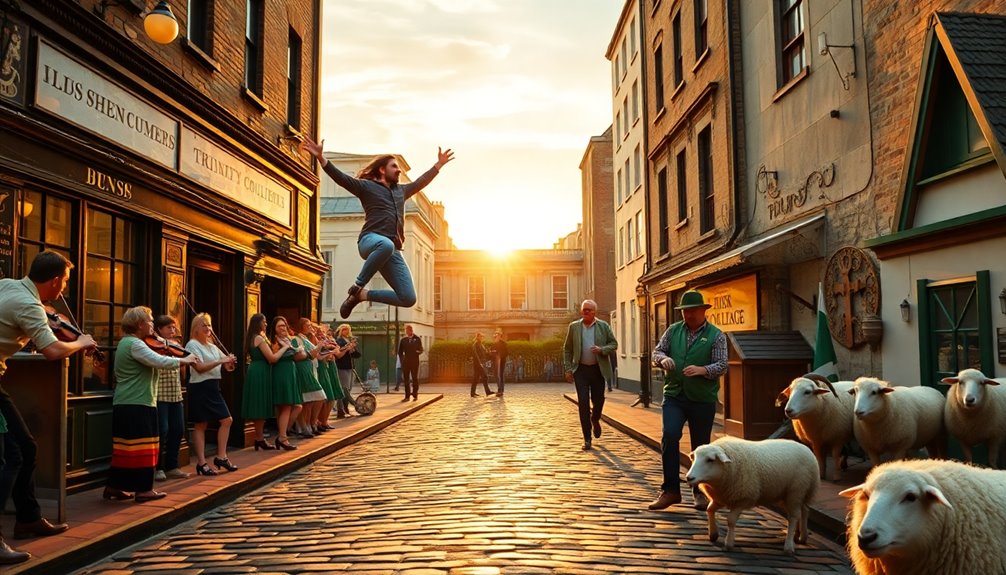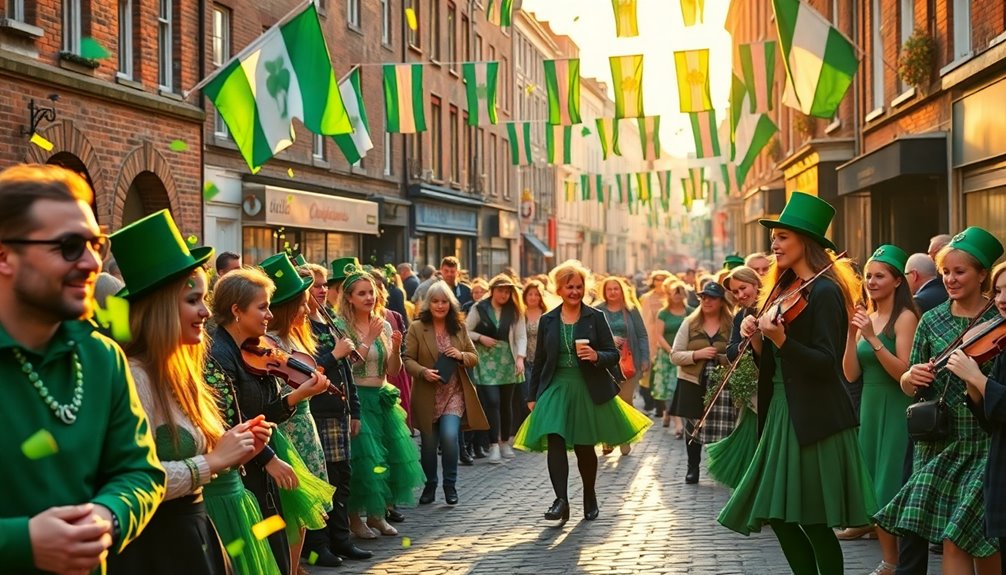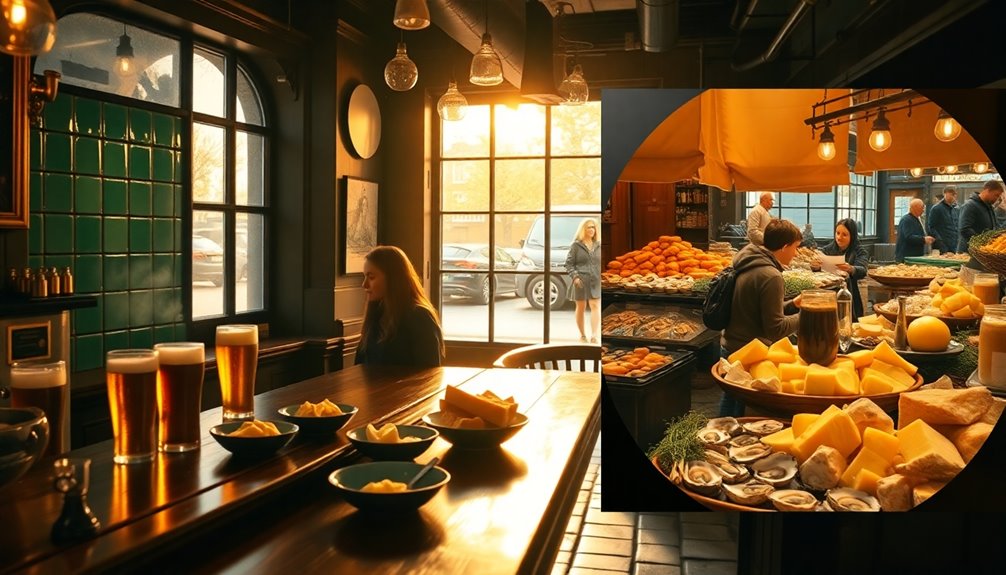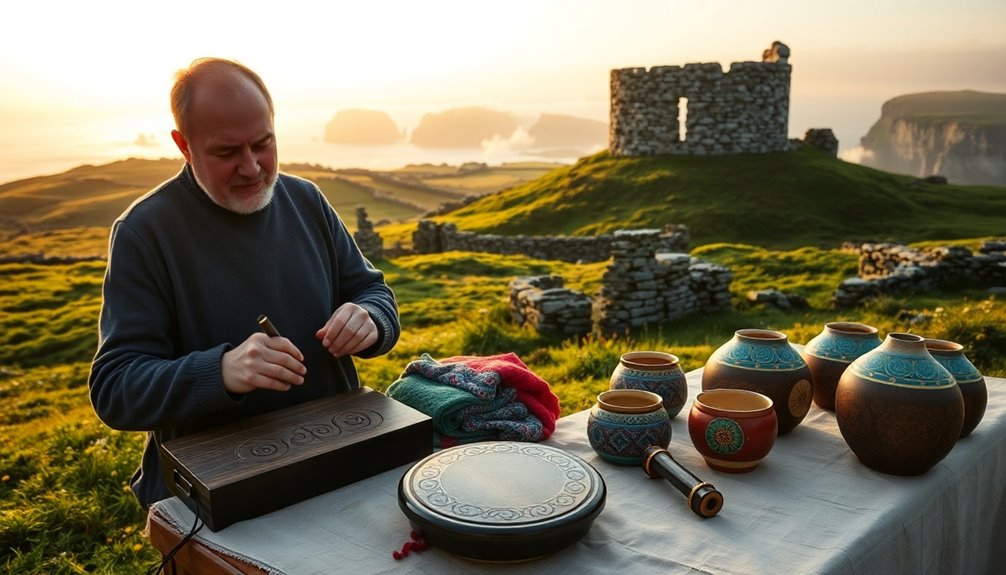
As a student in Ireland you’ll want to know music sessions in pubs, a few Gaeilge phrases, and dance traditions like stepdance and céilí. Festivals, storytelling nights, markets and hearty regional food make social life rich. Expect different rhythms in city and countryside, visual arts and crafts everywhere, plus churches, holy wells and secular community rituals. These touchstones help you fit in and feel at home — keep going and you’ll uncover practical tips and local details.
Traditional Irish Music Sessions and Pubs
Step into an Irish pub and you’ll often find a session—musicians gathered informally to play traditional tunes. You’ll feel free to listen, tap along, or join if you’ve got skill; sessions welcome respectful newcomers who follow pub etiquette like not interrupting tunes and waiting for a break. Watch for traditional instruments—fiddle, tin whistle, bodhrán, flute, accordion—and let the music guide you. Sit near enough to share warmth but give players space; buy a drink to show appreciation. Don’t dominate or demand songs; contribute with smiles and claps. Nights unfold organically, blending joy and craftsmanship. If you value freedom, you’ll love the open, collective spirit: everyone’s part of the music without strict rules, just mutual respect.
Gaelic Language and Local Dialects
You’ll find that Irish (Gaeilge) has basic phrases and grammar that are quick to pick up for everyday use. Regional dialects—from Munster to Connacht to Ulster—change pronunciation and some vocabulary, so listening locally helps you notice the differences. Check community classes, language cafés, and online resources to practice with native speakers nearby.
Irish (Gaelic) Basics
One important thing to know about Irish (Gaeilge) is that it’s not a single uniform language across the island—distinct dialects and regional pronunciations shape how it’s spoken in Donegal, Connemara, and Munster. Still, you can learn core basics that let you connect and move freely. Start with simple Gaelic phrases for greetings, numbers, and directions; they open doors and show respect. Practice pronunciation, basic grammar, and common verbs, but don’t obsess—communication matters more than perfection. If you can, try language immersion through conversation groups, classes, or local media to build confidence quickly. Embrace the learning as an act of cultural freedom: use what you learn, make mistakes, and enjoy being part of Ireland’s living language.
Regional Dialect Differences
Although Irish is a single language, its dialects—from Donegal in the north to Connemara in the west and Munster in the south—sound and behave quite differently, so you’ll notice variations in pronunciation, vocabulary, and grammar that can affect comprehension. You’ll hear regional accents shaping rhythm and melody: Donegal’s strong consonants, Connacht’s softer vowels, Munster’s unique intonation. Dialect variations mean words and sentence structures shift between communities, so you’ll sometimes need to adapt your listening and speech to connect. Embrace that freedom to explore different forms; it’s part of the language’s charm and identity. Respect local usage, ask questions, and let dialect differences expand your understanding rather than limit it.
Learning Resources Locally
Local learning resources make it easy to immerse oneself in Gaelic and its regional dialects, whether you want formal classes, conversation groups, or everyday practice. You can drop into local libraries for books, audio materials, and community noticeboards that point to tutors or exchange meetups. Cultural workshops run by artists and native speakers give hands-on chances to pick up idioms and pronunciation from Donegal to Munster. If you crave independence, join casual conversation circles, volunteer at events, or use mobile apps alongside in-person sessions to steer your own pace. Seek out language cafés and pop-up classes advertised around campuses and neighbourhoods; they’re practical, low-pressure ways to build fluency while you shape a learning path that fits your life.
Irish Dance: Stepdance and Ceili Traditions
When you watch Irish stepdance and céilí dancing, you’ll notice two distinct energies: the rigid upper body and lightning-fast feet of stepdance, versus the social, figure-driven patterns of céilí. You’ll learn stepdance techniques that sharpen rhythm and control, while ceili history teaches community moves and call-and-response timing. Both let you express independence within tradition — precision and freedom together.
| Style | Focus | Experience |
|---|---|---|
| Stepdance | Footwork, posture | Solo performance intensity |
| Céilí | Figures, formations | Group connection, joy |
| Practice | Drills, music | Skill + spontaneity |
Try classes or sessions to feel the drive, respect roots, and choose how tradition fits your own path.
Festivals and Seasonal Celebrations

Music and dance are woven into Ireland’s calendar, so it’s natural that stepdance and céilí traditions show up at the country’s many festivals and seasonal celebrations. You’ll join in St. Patrick’s Day parades and Cultural Parades that feel like open invitations to celebrate identity and freedom. You’ll see Halloween Traditions revived in playful, community-minded ways, while Summer Solstice and Winter Solstice events mark nature’s rhythm with bonfires or quiet gatherings. Harvest Festivals blend food, craft, and gratitude; Seasonal Markets sell local goods and spark connection. Music Festivals pulse with contemporary and traditional sounds, and Community Gatherings happen in halls, fields, and pubs. Religious Celebrations coexist with secular joy, so you can choose how to take part and belong.
Literary Heritage and Storytelling Nights
Because stories have been passed down by firelight and in crowded pubs for centuries, Ireland’s literary heritage feels alive—you’ll find it in books, on stages, and during intimate storytelling nights where oral tradition meets modern voices. You’ll roam lively literary festivals, catch readings from established and emerging writers, and swap ideas with locals who prize honest expression. Join storytelling workshops to sharpen your voice, learn techniques, and share pieces in supportive circles that welcome risk and originality. You’ll discover that narrative freedom is practiced here: poems, myths, and contemporary tales blend freely, inviting you to reinterpret the past and imagine new futures. Participate, listen, and contribute—these nights will expand your creative range and connect you with a spirited cultural community.
Irish Sports: Gaelic Games and Community Clubs
Story nights and pub readings show how storytelling keeps communities connected, and on the pitch you’ll find that same communal energy expressed through sport. You’ll join clubs where Gaelic football pulses with speed and teamwork, and hurling history echoes in every swing. Community involvement isn’t optional — it’s how clubs thrive, welcome newcomers, and pass traditions on. Local rivalries sharpen weekends, but they also build respect and freedom to play your way. Practices, matches, and volunteer days teach you teamwork, pride, and responsibility. You’ll find coaches who mentor and neighbors who cheer; becoming part of a club gives you roots without constraints, and lets you shape your own Irish experience.
| Skill | Tradition | Community |
|---|---|---|
| Teamwork | Roots | Support |
| Rivalry | History | Freedom |
Food Culture: Pubs, Regional Dishes, and Markets

When you walk into an Irish pub or market, you’ll notice food isn’t just fuel — it’s a way people gather, share history, and celebrate local flavors. You’ll find comforting pub food like stews, soda bread, and seafood chowder that’s simple, honest, and meant to be shared over conversation. Regional dishes change by coast and county, so you can taste oysters in Galway or farmhouse cheeses in Cork and feel connected to place. Weekends bring lively farmers markets where you can buy fresh produce, artisan bread, and smoked salmon from the source, talk to makers, and choose freely. Eating in Ireland is as much about community and curiosity as it is about flavor — try things, ask questions, and follow what excites you.
Rural Vs Urban Cultural Experiences
If you step out of a bustling city into the Irish countryside, you’ll notice culture shifting from fast‑paced, diverse scenes to slower, community‑centered rhythms where traditions hold stronger sway. You’ll find rural traditions alive in small gatherings, céilís, and local storytelling, where neighbors share history and music without pretense. In towns and cities you’ll join urban festivals that pulse with contemporary arts, multicultural food, and late-night energy, giving you choices each weekend. You can slip between both worlds: volunteer at a country fair one day, catch an indie gig in Dublin the next. That freedom to roam teaches you adaptability, respect for local customs, and how modern creativity and age-old ritual coexist across Ireland.
Religious and Spiritual Influence on Daily Life
Although Ireland has become more secular in recent decades, religion and spirituality still shape daily life in many communities — from the rhythm of Sunday masses and seasonal rites to the quiet presence of local parish halls and holy wells where people gather for reflection. You’ll notice spiritual traditions woven into community calendars and personal choices, but you’re free to engage how you like. Daily rituals — from lighting a candle to joining a pilgrimage — offer moments of pause without demanding conformity. You can respect heritage while keeping autonomy. Consider these everyday expressions:
- Morning or evening prayers and blessings that mark family life.
- Seasonal festivals linking faith, nature, and community volunteering.
- Informal gatherings at parish halls, graveyards, or holy wells for quiet reflection.
Visual Arts, Crafts, and Heritage Sites

Because Ireland’s visual arts and crafts are rooted in centuries of storytelling and skilled hands, you’ll find creativity everywhere from village studios to national galleries. You’ll explore visual storytelling in stone, textile, and paint, and meet contemporary artists who blend tradition with bold freedom. Visit craft markets, trace Celtic motifs at heritage sites, and let rural workshops inspire your own practice. You’ll appreciate accessible museums and open studios that welcome questions and hands-on learning. Embrace roaming—each site gives new perspective and permission to create. Below is a simple guide to get you started.
| Place Type | What to Expect |
|---|---|
| National Gallery | Iconic collections, rotating shows |
| Heritage Site | Ancient carvings, scenic context |
| Craft Market | Live makers, unique gifts |
| Studio Visit | Conversation, workshops |
Some Questions Answered
Can I Legally Work While Studying in Ireland as an International Student?
Yes — you can work while studying in Ireland if your study regulations allow it; you’ll typically need a work visa exemption tied to your student permission, so check your course level and hours to keep freedom intact.
How Easy Is It to Find Student Accommodation in Small Irish Towns?
It’s fairly doable but varies: you’ll find student housing more limited in small towns, with lower rental prices than cities; stay flexible, join local groups, and act quickly to secure freedom-friendly spots that suit your budget.
Are There Common Student Discounts for Cultural Events and Transport?
Absolutely — you’ll find loads of student deals for cultural access and transport, with discounts on gigs, museums and Leap/Student Leap cards; it’s practically endless, so you’ll feel free to explore Ireland affordably and wildly.
What English Accents Will I Encounter in Different Irish Regions?
You’ll hear diverse accents across Ireland: Dublin’s range from neutral to nasal urban; Cork’s lilting singsong; Belfast’s Northern Irish edge; rural Munster and Connacht show regional variations with softer vowels and distinct rhythms, giving spoken freedom and flavor.
How Safe Is Nightlife for Students in Irish Cities and Villages?
Like a lantern guiding you, nightlife is generally safe in Irish cities and quieter in villages, but you’ll need student awareness: stick with friends, trust instincts, avoid lone shortcuts, and enjoy freedom while respecting local norms.
